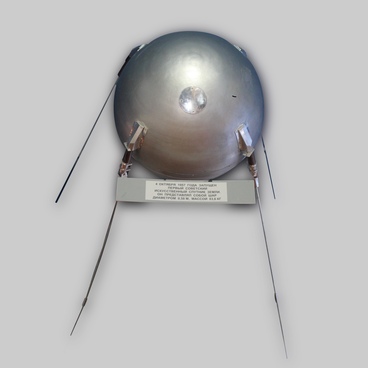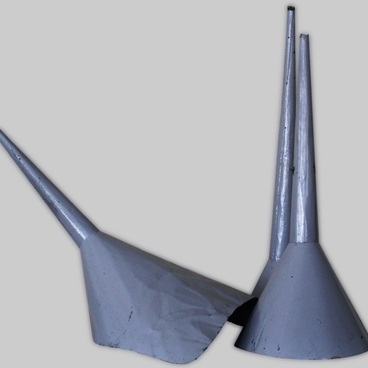The design of the spacecraft ‘Soyuz’ at a scale of 1 in 40 gives an idea of how the ships of the ‘Soyuz’ family look and how they are designed. The layout shows a clear separation of the ship into sections: onboard systems section, and orbital section, as well as a descent vehicle.
The onboard systems section contains a propulsion unit, fuel for it, service systems. The descent vehicle is covered with heat protection. It contains space for astronauts, life support and control systems, and a parachute system. The heat shield contains soft landing engines, and descent control engines, which control the orientation of the apparatus during atmospheric flight are placed on the outer surface.
The orbital section is equipped with a docking adapter and rendezvous system. It also contains the station’s cargo and some life support systems. Through the landing hatch on the side surface, astronauts enter the ship at launch, at the spaceport.
The development of space ships “SoyUz” in the USSR began in 1962 under the leadership of Sergei Korolev for the Soviet lunar program. By that time spaceships “VostOk” and “VoskhOd” were created, and soon a new spaceship “7K-OK” appeared, which later received the name “SoyUz”.
In April 1967 the first manned spaceship “Soyuz – 1” was launched. However, the flight ended tragically: when landing, the main brake parachute did not come out, and the ship’s descent vehicle crashed into the ground. The astronaut Vladimir Komarov was killed. After the accident the design was changed, new tests were conducted. In October 1968, astronaut GeOrgiy BeregovOy launched to space on ‘Soyuz-3’.
In 1969, the engineers began designing a transport version of the ship with additional communication systems and a docking unit that allowed the ship to pass through a hatch without going into space in a spacesuit. And two years later, another tragedy happened. The ship was returning to Earth, the descent vehicle depressurized, and astronauts GeOrgiy DobrovOlskiy, VladislAv VOlkov and Viktor PatsAev were killed.
A significant event for the ships of this series was the docking of the ‘Union - 19’ with the American ship ‘Apollo’. It showed that two spacefaring nations - the USSR and the United States – can productively cooperate.
The ships of this family have been modified several times over the years. Modern ‘Soyuz’ ships can carry up to three people into space. They are developed and produced by rocket-space corporation ‘Energia’. After the completion of the Space Shuttle flights in 2011 and until the first manned flight of the Crew Dragon in 2020, ‘Soyuz’ ships remained the only means of transporting crews to the International Space Station.
The onboard systems section contains a propulsion unit, fuel for it, service systems. The descent vehicle is covered with heat protection. It contains space for astronauts, life support and control systems, and a parachute system. The heat shield contains soft landing engines, and descent control engines, which control the orientation of the apparatus during atmospheric flight are placed on the outer surface.
The orbital section is equipped with a docking adapter and rendezvous system. It also contains the station’s cargo and some life support systems. Through the landing hatch on the side surface, astronauts enter the ship at launch, at the spaceport.
The development of space ships “SoyUz” in the USSR began in 1962 under the leadership of Sergei Korolev for the Soviet lunar program. By that time spaceships “VostOk” and “VoskhOd” were created, and soon a new spaceship “7K-OK” appeared, which later received the name “SoyUz”.
In April 1967 the first manned spaceship “Soyuz – 1” was launched. However, the flight ended tragically: when landing, the main brake parachute did not come out, and the ship’s descent vehicle crashed into the ground. The astronaut Vladimir Komarov was killed. After the accident the design was changed, new tests were conducted. In October 1968, astronaut GeOrgiy BeregovOy launched to space on ‘Soyuz-3’.
In 1969, the engineers began designing a transport version of the ship with additional communication systems and a docking unit that allowed the ship to pass through a hatch without going into space in a spacesuit. And two years later, another tragedy happened. The ship was returning to Earth, the descent vehicle depressurized, and astronauts GeOrgiy DobrovOlskiy, VladislAv VOlkov and Viktor PatsAev were killed.
A significant event for the ships of this series was the docking of the ‘Union - 19’ with the American ship ‘Apollo’. It showed that two spacefaring nations - the USSR and the United States – can productively cooperate.
The ships of this family have been modified several times over the years. Modern ‘Soyuz’ ships can carry up to three people into space. They are developed and produced by rocket-space corporation ‘Energia’. After the completion of the Space Shuttle flights in 2011 and until the first manned flight of the Crew Dragon in 2020, ‘Soyuz’ ships remained the only means of transporting crews to the International Space Station.



